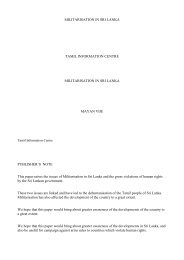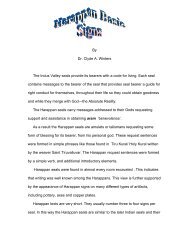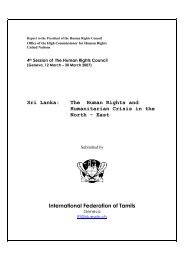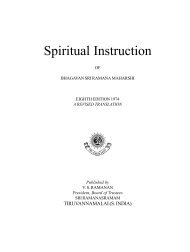Asymmetric Warfare And Low Intensity Maritime Operations
Asymmetric Warfare And Low Intensity Maritime Operations
Asymmetric Warfare And Low Intensity Maritime Operations
- No tags were found...
You also want an ePaper? Increase the reach of your titles
YUMPU automatically turns print PDFs into web optimized ePapers that Google loves.
ORF Occasional Paper<strong>Asymmetric</strong> <strong>Warfare</strong> <strong>And</strong> LIMO: Challenges For Indian Navynoticed that they were being watched by Indian forces and began dumping items overboard.Sri Lankan naval forces intercepted a dingy with six-armed LTTE cadre andcommunications equipment. Reportedly, Indian and Sri Lankan navies have instituteda range of measures to step up surveillance to prevent LTTE smuggling arms across thenarrow northern strait separating the two countries.To that extent, the ‘kamikaze’ approach poses major challenges to naval forces. Navieswill need to concentrate on newer threats, as these would require new approachesand new methods. There will be added demands on scientific innovation, planning andintelligence information. Therefore, the new threats demand a freshly articulated maritimestrategy keeping in mind that the asymmetric approach is the most favoured strategyfor the terrorists.PiracyPiracy at sea continues to top the list of threats posed to merchant shipping. The 2004Annual Piracy Report published by the International <strong>Maritime</strong> Bureau (IMB) highlightsthe inability of maritime nations, particularly Indonesia (93 piratical attacks), to controlsea piracy in their waters. There were a total of 325 piracy attacks on shipping in 2004.This figure is lower than the reported 445 attacks in 2004 but the most worrying partof the report is that the number of crew killed increased to 30 as compared to 21 in2003. Besides, 86 shipping crew were kidnapped and pirates demanded ransom for theirrelease. Many of these attacks were serious and involved vessels being fired upon andcrew kidnapped for ransom. As many as 36 crew were kidnapped, four killed and threeinjured in the Malacca Straits.Indonesia and Malacca Straits appear to be popular among pirates. This is due togeographical and operational reasons. The area around the straits attracts the heaviestmaritime traffic concentration. As noted earlier, over 200 vessels of different types transitthe Malacca Strait every day and the traffic density is very high. Although there is atraffic separation scheme, transiting vessels reduce speed to negotiate the traffic. VeryLarge Crude Carriers (VLCCs) transit the strait at safe speeds with only a metre or twoof clearance under the keel. Besides, the strait is home to several shipwrecks and shallowareas. These navigational and operational conditions provide the right type of environmentfor pirates to undertake attacks as also manage a quick getaway. The number ofattacks is fast increasing and is alarming.In the recent past, the waters off Sri Lanka have witnessed frequent acts of piracy.In one incident, a merchant vessel, M V Cordiality, was captured and five Chinese crewwere allegedly killed by Sri Lankan terrorists near the port of Trincomalee. 27 LTTE rebelforces are also reported to have hijacked ships and boats of all sizes, and kidnapping andkilling crew members is a common practice. In August 1998, a Belize flagged generalcargo vessel, M V Princess Kash was hijacked by LTTE rebels. 28 While on its way to Mullaitivu, a LTTE stronghold , the Sri Lankan Air Force bombed the vessel to prevent theship’s cargo falling into the hands of LTTE. The status of the 22-crew members is stillnot known.The International <strong>Maritime</strong> Bureau has warned commercial shipping transitingalong the east coast of Africa not to come within 50 nautical miles of the coastline becauseof pirates. Most of the ports in the Horn of Africa are piracy prone and dangerous.Attacks occur in port, at anchor or during slow steaming off the coast. Somali watersin particular have been notorious for acts of piracy. This is primarily due to politicalinstability. Somali militias operate speedboats and are reported to pose as coastguard.Their activities include kidnappings, vessel seizures and ransom demands. The mostdangerous aspect of these activities is the frequent use of infantry weapons like mortars,grenades and small arms.In January 2002, a Lebanese vessel, Princess Sarah, was attacked and hijacked twiceoff the coast of Somalia. 29 In the first instance, the vessel was fired at while underway.In the process it sustained some damage and was forced to stop after 20 miles to makerepairs to the engine. Two days later a second attack took place and the pirates managedto take over the vessel. The initial ransom demand was for $60,000, but later this waschanged to $200,000. An agreement was reached on an undisclosed amount and thecrew was released. A French navy vessel was sent to oversee the release. The troubles ofthe vessel did not end there, because another attack took place and this time the pirateswere scared away by a helicopter that was sent by the nearby French warship Floreal.In June 2002, the Cyprus-flagged Panagia Tinou, a bulk carrier, was hijacked while itwas at anchor off the North coast of Somalia. 30 The crew was taken hostage and the shipwas moved to an unknown destination along the Somali coast. The United Nations enteredinto negotiations with the pirates on behalf of the Philippines since Somalia has nobilateral relations with it. After 16 days of captivity the crewmen were released in returnfor a ransom of $400,000, paid by an international shipping insurance agency throughthe Protection and Indemnity Club. According to the commander of the German NavalAir Wing Detachment in Mombasa, the presence of three German vessels near wherethe hijacked vessel was anchored helped free it.Pirates are like sharks. They breed and show up more often in some regions than others.They can strike anywhere but some areas are popular with them. Unfortunately, theIndian Ocean is home to the top three piracy infested regions. South East Asia, SouthAsia and the east African coast are hotspots of piracy and account for more than half ofthe worldwide reported attacks. It appears the centre of gravity of privacy keeps shifting,but pirate plagued areas remain active. It may simply happen that one area may record11www.orfonline.orgwww.orfonline.org 12
















